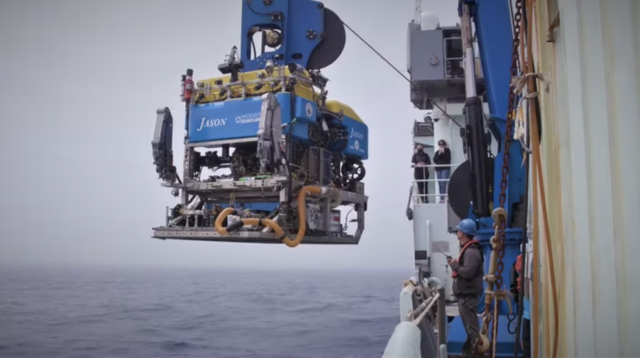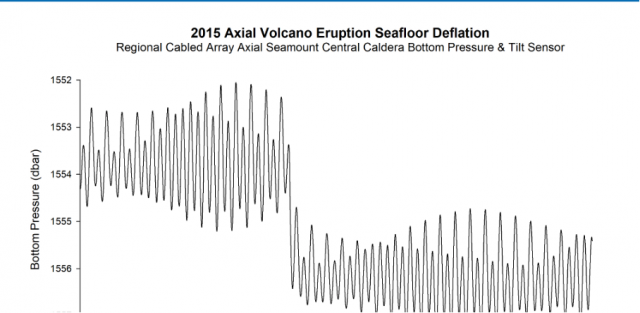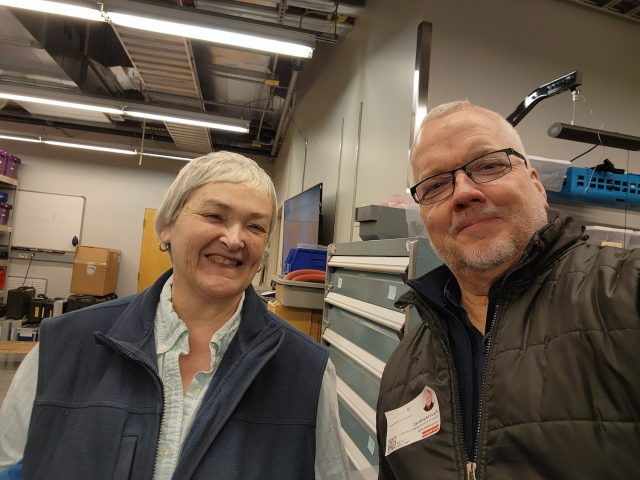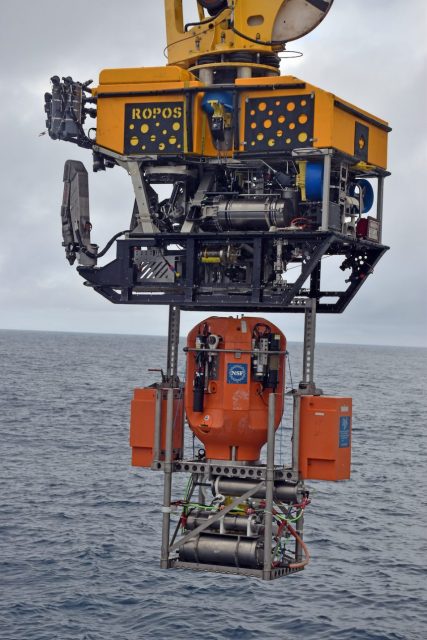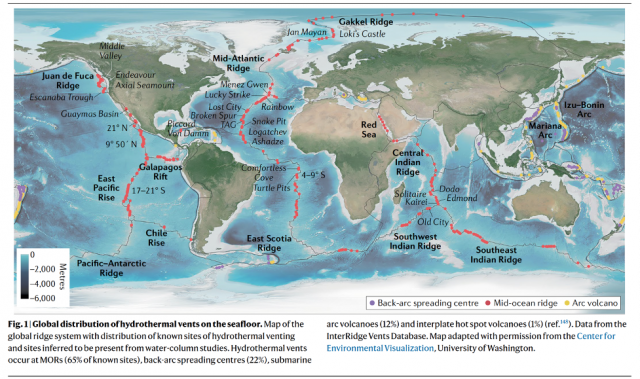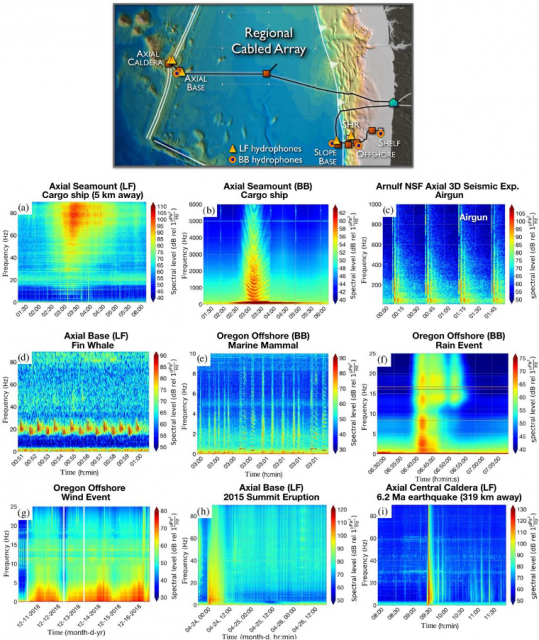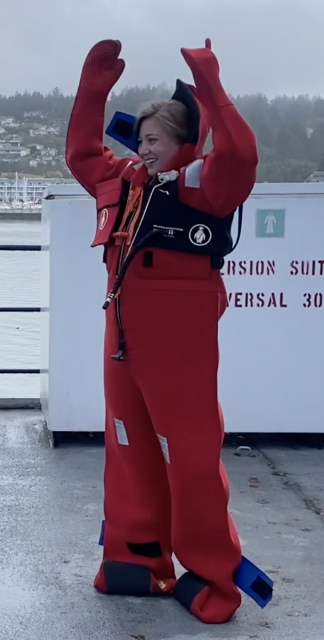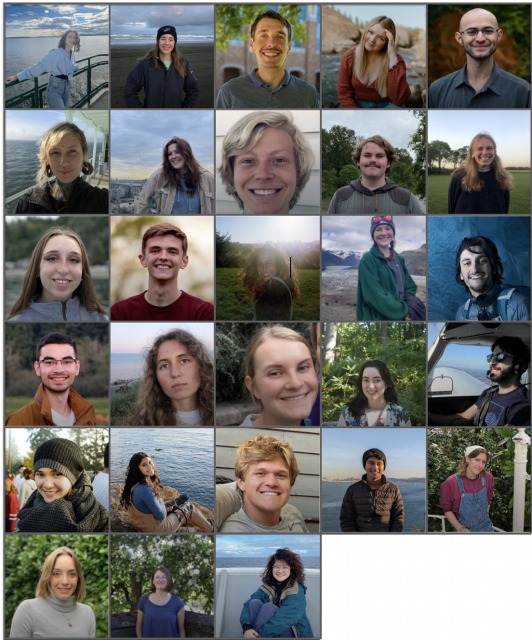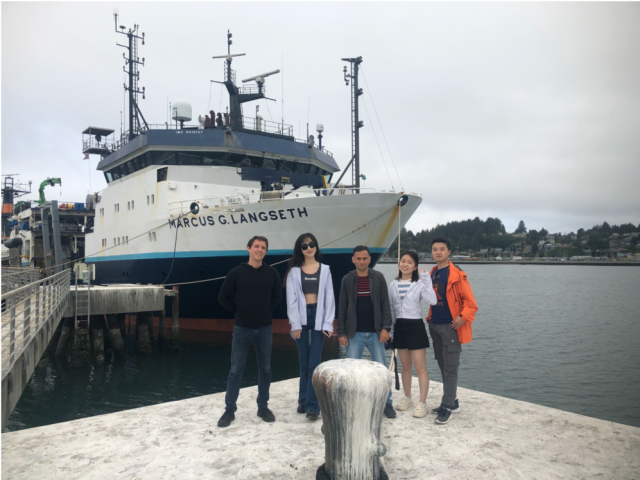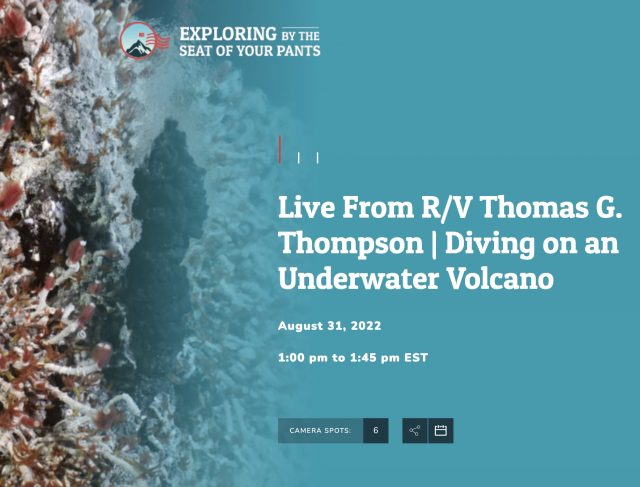Posts Tagged ‘Regional Cabled Array’
Axial Seamount Helping Scientists Forecast Eruptions
On March 20, 2023, Oregon Public Radio reported about scientists work at Axial Seamounts, a seamount and submarine volcano on the Juan de Fuca Ridge, about 480 kilometers off the coast of Oregon. The story details how bottom pressure recorders connected to OOI’s Regional Cabled Array are helping reveal the inner workings of the Axial Seamount and helping scientists forecast when it might erupt next. Featured are Oregon State University Professor Bill Chadwick, University of North Carolina Professor Scott Nooner, Oregon State University Assistant Professor Jeff Beeson, and College of Charleston Assistant Professor Haley Cabannis.
Access the article here.
Read MoreMaking the Ocean Accessible Through Sound
“Scientists are finding that people can sometimes pick up more information from their ears than the eyes can see. And ears can perceive patterns in the data that the eyes can’t see,” said Amy Bower, a Senior Scientist at Woods Hole Oceanographic Institution and Principal Investigator for the Accessible Oceans project. “Adding sound to science allows more people to experience science, follow their curiosity, and make science more accessible to all. “
Bower joined forces with a multidisciplinary team to explore ways sound could be used to visualize data. Funded by the National Science Foundation’s Advancing Informal STEM Learning Program, Bower and her team have been working for nearly two years on Accessible Oceans: Exploring Ocean Data through Sound. Their goal is to inclusively design and pilot auditory displays of real ocean data. They are implementing a process called sonification, assigning sound to data points. Each member brings expertise to the task at hand. Principal Investigator Bower is an oceanographer. Dr. Jon Bellona is a sound designer with specialization in data sonification at the University of Oregon. Dr. Jessica Roberts and graduate student Huaigu Li, both at Georgia Tech, are Learning Sciences and human-computer interaction experts. Dr. Leslie Smith, an oceanographer and specialist in ocean science education and communication at Your Ocean Consulting, Inc., rounds out the team. Bower is a blind scientist, who lends a crucial perspective in the research and overall execution of the project.
To begin, the team chose to use datasets collected by the Ocean Observatories Initiative (OOI) that had previously been transformed into classroom-ready use by Smith and the Ocean Data Labs. The team is working first on three of these curated datasets: the 2015 eruption of Axial Seamount, the vertical migration of zooplankton during an eclipse event, and carbon dioxide exchange between the ocean and the atmosphere.
“Data is made of numbers. Sonification is basically just translating numbers into sound,” Bower explained. “So instead of seeing numbers go up and down on a graph, for example, you can hear them go up and down.”
To ensure an inclusive final product, the team has undertaken a co-design process in which a variety of stakeholders have been engaged for input throughout the process. The team interviewed both subject matter experts and teachers of the blind and visually impaired to ensure that both scientific and pedagogical needs were being met. They then explored the integration of various auditory display techniques and ended up with a mix of data sonification, narration, and environmental sounds. The team put together a sample of five to six sonification examples for each data set, then surveyed a group of blind, visually impaired and sighted adults and students with science and non-science backgrounds. The survey’s purpose was to ask which sounds and which approaches might work best for both sighted and visually impaired listeners.
“We asked, for example, which of these sounds do you think best represents gases coming in and out of the ocean. The feedback was overwhelmingly in favor of a breathing sound,” said Bower. “As listeners will hear in the first example below that deals with carbon dioxide exchange between the ocean and the atmosphere, the breathing sound, with narration explaining what to expect, really brings the data to life.”
Accessible Oceans is a pilot and feasibility study for a museum exhibit that would introduce the broader public to what it’s like to experience ocean data through sound. At the end of this two-year project, the team intends to submit another proposal to design and build an exhibit that make ocean data come alive in a new and accessible way.
“As we’ve been working on this project, we’ve come to realize that to engage more people in science, technology, engineering and math, we can appeal to their ears as well as their eyes,” added Bower. “And I’m determined to help make science as accessible as possible for everyone.”
________________________________________________________________________
To hear more about Amy Bower’s work as an oceanographer and her exploration of sonification, tune into this episode of The Science of Ocean Sounds, Tumble Science Podcast for Kids.
Read More
Visit to West Coast OOI Facilities
A group of Ocean Observatories Initiative (OOI) leaders visited OOI facilities at Oregon State University and the University of Washington last week to get a first-hand look at operations of the Coastal Endurance Array and Regional Cabled Array, respectively. National Science Foundation Program Director George Voulgaris, OOI Principal Investigator Jim Edson and Senior Program Manager Paul Matthias spent five days on the road meeting with their OOI west coast colleagues. The trip was designed to give recently appointed Voulgaris an opportunity to inspect the infrastructure and meet team members who keep the Coastal Endurance and Regional Cabled Arrays operational and reporting back data around the clock. Edson and Matthias seized the opportunity to meet in person with colleagues who they routinely see on the screen.
The following provides a glimpse of some of the activities that occurred during the trip:
[media-caption path="https://oceanobservatories.org/wp-content/uploads/2023/02/20230207_140014.jpg" link="#"]Grant Dunn, Mechanical Engineer with the Electronic & Photonic Systems Department at UW-APL (left) describes the level-wind system on the RCA profiler mooring to Dr. George Voulgaris during a tour of the RCA laboratory facilities at the University of Washington as RCA Project Manager Brian Ittig looks on. Credit: Paul K. Matthias © WHOI.[/media-caption] [media-caption path="https://oceanobservatories.org/wp-content/uploads/2023/02/20230207_144911.jpg" link="#"]Regional Cabled Array Principal Investigator Deborah Kelley (left) and OOI Senior Program Manager Paul Matthias take a selfie to commemorate their in-person visit during a tour of the RCA facilities at the University of Washington. Credit: Paul K. Matthias © WHOI.[/media-caption] [media-caption path="https://oceanobservatories.org/wp-content/uploads/2023/02/20230207_141656.jpg" link="#"]NSF Program Director George Voulgaris (from left), OOI Principal Investigator Jim Edson look on as Regional Cabled Array technicians Grant Dunn, Mechanical Engineer with the Electronic & Photonic Systems Department at UW-APL, and RCA Chief Engineer Chuck McGuire explain the engineering associated with the RCA profiler mooring during a tour of RCA’s facilities at the University of Washington. Credit: Paul K. Matthias © WHOI.[/media-caption] [media-caption path="https://oceanobservatories.org/wp-content/uploads/2023/02/20230209_123758.jpg" link="#"]NSF Program Director George Voulgaris (left) asks OSU technician Jonathan Whitefield questions about glider operations that provide critical water column data around the moorings of the Coastal Endurance Array. Credit: Paul K. Matthias © WHOI.[/media-caption] [media-caption path="https://oceanobservatories.org/wp-content/uploads/2023/02/20230207_112718.jpg" link="#"]NSF Program Director George Voulgaris (foreground) and RCA Chief Engineer Chuck McGuire discuss the RCA data monitoring systems as OOI PI Jim Edson points to real-time data on the screen being relayed by instrumentation on the Regional Cabled Array. Credit: Paul K. Matthias © WHOI.[/media-caption] [media-caption path="https://oceanobservatories.org/wp-content/uploads/2023/02/20230209_130353.jpg" link="#"]NSF Program Director George Voulgaris (left) gets a hands-on look at the multiple instruments contained on multi-function node that will sit on the bottom of the ocean floor for six months collecting data for the Coastal Endurance Array. Coastal Endurance Array Principal Investigator Ed Dever (middle) and Project Manager Jonathan Fram the functionality of each instrument during the visit to Oregon State University. Credit: Paul K. Matthias © WHOI.[/media-caption]
Read More
RCA and ROPOS: A Long-Term International Collaboration
A Canadian and American team worked side-by-side for 45 days in August in the NE Pacific Ocean during the eighth operations and maintenance expedition for OOI’s Regional Cabled Array (RCA). The team used the Canadian remotely operated vehicle (ROV) ROPOS to conduct maintenance operations on RCA’s underwater cabled observatory spanning the Juan de Fuca Plate and at water depths from 80 m to 2900 m. Intense operations included the recovery and reinstallation of 222 instruments and a 2700 m-tall, two-legged Shallow Profiler Mooring. This expedition took place on the global class research ship the R/V Thomas G. Thompson, operated by the University of Washington (UW). Twenty-six students joined the cruise as part of the UW at-sea experiential learning program called VISIONS.
ROPOS is operated by the Canadian Scientific Submersible Facility (CSSF). The vehicle was specially designed for cabled observatory work, bringing in components from the oil and gas field, and a uniquely designed Remotely Operated Cable Laying system (ROCLS) that allows the vehicle to install extension cables extending for several kilometers on the seafloor. Their work culminated in 2014 during an 83-day cruise onboard the R/V Thompson, which resulted in the installation of >15,000 m of extension cables (in total, ~33,000 m of extension cables was installed on the seafloor), >140 instruments, and platforms on the six-state of-the art moorings with instrumented profiling vehicles. They also installed 18 junction boxes at the key experimental sites using their underbelly latching system that allows the vehicle to directly secure loads up to 4,000 lbs beneath the vehicle. This latching system was adopted by the Deep Submergence Facility ROV Jason, which has conducted multiple RCA maintenance cruises.
[media-caption path="/wp-content/uploads/2022/12/R2209_20220812_091705_launch_ME.Axial-Base_Science-Pod_install-2.jpg" link="#"]The Shallow Profiler Science Pod being deployed with ROPOS during Leg 1 of the RCA 22 cruise at Axial Base. Credit: M. Elend, University of Washington, V22.[/media-caption]
During this latest expedition, ROPOS conducted 60 dives over 33 at-sea days. Keith Tamburri led seven members of the ROPOS team, who worked 12 hours on, 12 hours off for 45 days. Operations are more similar to industry with as little time on deck as possible for the ROV, typically about three hrs before ROPOS reentered the water. Team work is exemplified during ROPOS operations where two pilots each operate a manipulator to conduct complex operations. The ROPOS team was joined in the dive control laboratory by varying members of the RCA’s team, who directed ROPOS activities on the seafloor and throughout the water column, and the VISIONS’22 students who stood 4 hour watches. (A list of ROPOS and RCA team members can be found here).
During this 8th RCA recovery and deployment expedition, the R/V Thompson traveled to all of the RCA sites. ROPOS recovered and redeployed a diverse array of instruments and four small seafloor substations that provide power and communications to instruments on the seafloor and to the instrumented Deep and Shallow profiler moorings. The ROV also was used to install a 500 m long extension cable that allowed bringing the Southern Hydrate Ridge live again. ROPOS also recovered equipment and samples for externally funded principal investigators, including several novel instruments developed by scientists in the US and Germany. ROPOS tasks were many and varied. The vehicle emplaced packages up to 3200 lbs in weight and the pilots skillfully used the manipulators to do everything from scrubbing biofouling off cables to unplugging and plugging in instruments to the seafloor cable
In addition to RCA operations, ROPOS was used to help advance scientific investigations involving instruments added onto the RCA cabled network. For example, as part of an Early Career award to for Dr. Rika Anderson at Carleton College, ROPOS conducted sampling dives using a Universal Fluid Obtainer on the ROPOS porch to sample fluids for follow-on analyses of microbes and viruses. Through another NSF award to Dr. Wilcock and his UW colleague Dana Manalang, ROPOS installed a first of its kind acoustic network on the western and eastern rim of Axial Seamount and within its caldera to examine deformation within the caldera. A suite of CTD instruments were also turned within the caldera to test the hypothesis that brines are emitted from the subsurface associated with submarine eruptions as part of and NSF award to Dr. William Chadwick at the Oregon State University. Lastly, ROPOS inspected a Quantification sonar and recovered an Overview Sonar on Southern Hydrate Ridge as part of a project funded by the German Federal Ministry of Education and Research to MARUM at the University of Bremen, led by investigators Gerhard Bohrmann and Yann Macron. In addition, their 4K high-definition camera was cleaned and a CTD turned. The sonar and camera instruments are another example of an international collaboration.
“Our ROPOS team really enjoys working with the team from the University of Washington, School of Oceanography and Applied Physics Laboratory, who are responsible for the RCA. They are a professional, well-organized, efficient, friendly, and mutually respectful group, which makes these long missions at sea productive, efficient, and successful,” said Keith Shepherd, General Manager, Canadian Scientific Submersible Facility. “And for this cruise, in particular, it was a real pleasure working along with UW undergraduates onboard as part of UW’s at-sea experiential program VISIONS. The students brought a curiosity, enthusiasm, and energy that were always welcome during the long hours in the dive control van.”
Added Kelley, “It really takes a tremendous amount of time, effort, and teamwork to pull off an expedition of this length and complexity. We are grateful to have had the opportunity to work again with our Canadian colleagues. It was an excellent international collaboration to help maintain and expand the capabilities of the RCA. “ Because of the complex nature of the undersea work required to keep the RCA operational, few facilities are trained and equipped to execute such operations.
[media-caption path="/wp-content/uploads/2022/12/ROPOS-ROCLS_IEEE-copy-2.jpg" link="#"]ROPOS with the cable laying system ROCLS attached during the 2014 deployments of the extension cables. Credit: M. Elend, University of Washington, V14.[/media-caption]
Read More
Nature Review Paper Reveals New Understandings of Mid-Ocean Ridge Systems
Only a small percentage of the global seafloor has been investigated, leaving the deep ocean as one of the last frontiers to be explored and sampled. Mid-ocean ridges (MOR) systems extend about 60,000 kilometers around the globe, are where 70% of the volcanism on Earth occurs, and are dynamic and active tectonic regions.
A recent Nature Review paper, Früh-Green, et al. 2022, written by a multi-disciplinary team of experts summarizes what is known about MORs, their importance in regulating seawater chemistry and global chemical fluxes, and the diverse ecosystems that they support in the absence of light and under extreme conditions. The authors describe the tectonic, magmatic, and hydrothermal processes that govern how they form and change and describe some of the biogeochemical cycles at varying spreading rates.
“The first hydrothermal vent was discovered in 1977, which was followed by myriad discoveries about these amazing deep-sea environments over the next 45 years,” said OOI’s Regional Cabled Array Principal Investigator, Deborah Kelley at the University of Washington and an author of the paper. “Yet, much remains to be understood about these environments, which play a key role in regulating seawater chemistry and global chemical fluxes. Key unknowns include the evolution of the novel microbial communities that they host and the diversity of viruses. This paper summarizes some of the key discoveries that researchers have made and questions that remain to be answered.”
Among the paper’s key findings are:
- Spreading rates control variations in heat sources, magma input, and tectonic processes along MORs, providing multi-faceted habitats for life.
- Seawater circulation and hydrothermal alteration regulate seawater chemistry and change the composition and physical properties of the lithosphere (crust and upper mantle).
- Roughly 50-60% percent of global MORs are spreading at slow to ultraslow rates resulting in the exposure of lower crustal and upper mantle rocks. This spreading is creating asymmetric ridge segments that support different structures, hydrothermal processes, and vent fluid chemistry.
- Serpentinization decreases density and seismic velocities of mantle rocks, weakening the oceanic lithosphere along faults. Serpentinization also produces hydrogen and organic molecules that provide energy for microbial life.
- Unlike serpentinizing systems, basalt-hosted systems support a vast, hot and diverse microbial biosphere. Advanced technologies are allowing better characterization of the genetic makeup and metabolism of microbes and the role of viruses in shaping biodiversity.
- Hydrothermal processes govern global chemical fluxes of magnesium, iron, manganese, and other volatiles and provide nutrients to the deep ocean. Microbial interactions and oxidation of organic compounds within hydrothermal plumes produce organic carbon.
[media-caption path="/wp-content/uploads/2022/11/Screen-Shot-2022-11-29-at-10.54.32-AM.png" link="#"]Global distribution of hydrothermal vents on the seafloor. Map of the global ridge system with distribution of known sites of hydrothermal venting and sites inferred to be present from water-column studies. Hydrothermal vents occur at MORs (65% of known sites), back-arc spreading centers (22%), submarine arc volcanoes (12%) and interplate hot spot volcanoes (1%). Data from the InterRidge Vents Database. Map adapted with permission from the Center for Environmental Visualization, University of Washington.[/media-caption]
“Ocean observatories like OOI’s Regional Cabled Array and Ocean Networks Canada , are providing researchers unprecedented real-time views into these highly dynamic regions that help form the face of our planet,” added Kelley. “RCA has allowed researchers to measure and monitor activity at the magmatically robust Axial Seamount, on the Juan de Fuca MOR for example, providing insights into when it might next erupt. Such underwater observatories will only continue to advance our knowledge as we expand capabilities to observe, monitor, and sample seafloor environments and the overlying water column in real time with more sophisticated sensors and advanced underwater vehicles and robotic technologies.”
Reference:
Früh-Green, G.L., Kelley, D.S., Lilley, M.D. et al. Diversity of magmatism, hydrothermal processes and microbial interactions at mid-ocean ridges. Nat Rev Earth Environ (2022). https://doi.org/10.1038/s43017-022-00364-y
Read More
An Overview of Ambient Sound Using OOI Hydrophones
Adapted and condensed by OOI from Ragland, et al., 2022, doi.org/10.1121/10.0009836.
[media-caption path="/wp-content/uploads/2022/11/RCA-highlight.png" link="#"]Figure 1: Highlights of acoustic features from the five low frequency (Fs=200Hz) and six broadband (Fs = 64 kHz) hydrophones on the RCA.[/media-caption]Ragland et al., (2022) provides a wonderful overview of the unique opportunities for data and experimentally driven advancements in acoustics that are provided by (long-term) ambient sound recordings streamed live from hydrophones on the Regional Cabled Array. Figure 1, above (after Figure 5, Ragland et al., 2022), highlights acoustic features from the five low frequency (Fs=200Hz) and six broadband (Fs = 64 kHz) hydrophones on the RCA. Areas of research span the rare ability to conduct offshore monitoring of Fin whale migration, and the seasonal fluctuations and decade-long evolution of their calls, in situ offshore meteorological measurements with high temporal resolution to study wind and rain noise in the NE Pacific, the sound from commercial ships with impacts on the oceanic environment and marine life, ambient noise interferometry, volcanic eruptions, and both local and far-field earthquakes. As the authors note, the RCA-OOI data also provide significant opportunities for the development of machine learning tools for ocean acoustics. This work was supported by an award from the Office of Navy Research. The authors developed a public Python package (OOIPy) to access and explore the hydrophone data more easily (Schwock et al., 2021). OOIPy is also accessible through the OOI website tab Community Tools and Datasets.
__________________________________________________________
Ragland, J., F. Schwock, M. Munson, and S. Abadi (2022) Journal of the Acoustic Society of America, 151, 2085-2100, https://doi.org/10.1121/10.0009836.
Schwock, F., J. Ragland, L. Setiawan, M. Munson, D. Volodin, and S., Abadi (2021). OOIPY v1.1.3: A Python toolbox designed to aid in the scientific analysis of Ocean Observatories Initiative data, https://doi.org/10.5281/zenodo.5889288.
Read More
Student Videos Give Inside Look at Research and Safety
Four students from Queens College were aboard the R/V Marcus G Langseth for a recent ten-day research expedition to the Axial Seamount, a submarine volcano in the northeast Pacific Ocean that erupted in 1998, 2011, and 2015. The students were assisting a National Science Foundation Research team that is deploying autonomous ocean-bottom seismometers on OOI’s Regional Cabled Array as part of a two-year experiment taking place within the predicted time window of the next eruption.
The NSF-funded project is led by William Wilcock from the University of Washington and co-led by Felix Waldhauser, Columbia Climate School’s Lamont-Doherty Earth Observatory, who served as chief scientist on this expedition, Maya Tolstoy (UW), and Yen Joe Tan from the Chinese University of Hong Kong, who also was onboard.
Queens college graduate student Jacqueline Singer was onboard to further work towards her master’s degree. She teamed up with undergraduates Rania Taib, Hema Muni, and Julia Sandke to create two videos – one explains their research, while the other provides an insider’s look at safety issues at sea. In the first video, the students give an in-depth look at how they deployed 15 autonomous ocean-bottom seismometers and how they work. In the second video, the students explain the importance of survival suit training, followed by a humorous look at the complex movements needed to successfully suit up in a “Gumby suit.”
Columbia University PhD candidate Theresa Sawi also provides a written account of the expedition here.
https://vimeo.com/user110037220/studentsataxialseamount
https://vimeo.com/user110037220/gumbysuitdemo
Read MoreVisions’22: Changing Students Lives
From Deb Kelley, UW, in OOI Quarterly Report, 2022.
This year, 25 undergraduate students and three graduate students participated on the Regional Cabled Array Operations and Maintenance cruise as part of the VISIONS’22 at-sea experiential learning program. They include students from the US, India, Saudi Arabia, France, and Kazakhstan. They represent a breadth of disciplines spanning Oceanography (11), Engineering (9: Mechanical, Industrial, Bioengineering, Environmental, and Aeronautics and Astronautics), Biology (6: Biology, Marine Biology, and Microbiology), Geology (1), and Policy Studies focused on ocean equity and the United Nations Convention (1). They stood 4 hour-on, 8 hour-off watches in the remotely controlled vehicle, ROPOS control center, learned how to conduct CTD casts and collect and process fluid samples, and worked on deck. Three additional undergraduate student ambassadors, who have participated in past VISIONS’ expeditions (1-3 years), helped mentor the students. All completed cruise blogs on the Interactiveoceans VISIONS’22 Expedition site, and science-engineering and/or engagement projects that will last a quarter to several years. Two students chose projects involving advanced genetic analyses of vent animals and protists for their Senior Thesis in Oceanography. Based on discussions with past students and what they relayed in their blogs, for many this is a life changing experience. Note: two past VISIONS students are now APL engineers as part of the RCA team.
Read More
Catching the Next Eruption of Axial Seamount
Theresa Sawi, a PhD student in Columbia’s Department of Earth and Environmental Sciences and the Lamont-Doherty Earth Observatory, shares her reflections and more about the science behind a six-day research expedition to Axial Seamount. She gives a behind the scenes look as researchers from Columbia University on the R/V Marcus G Langseth deployed 15 autonomous ocean-bottom seismometers atop Axial Seamount, a submarine volcano in the northeast Pacific Ocean that erupted in 1998, 2011, and 2015. The research expedition was part of a two-year experiment taking place within the predicted time window of the next eruption.
The seismometers were added to OOI’s Regional Cabled Array. To read Sawi’s account, click here.
[media-caption path="/wp-content/uploads/2022/09/Langseth.png" link="#"]15 scientists were onboard the Langseth, with ranks ranging from professor to undergraduate researcher. Credit: Theresa Sawi.[/media-caption]Read More
Interview from Axial Seamount
In case you missed it, you can watch the video of Chief Scientist Michael Vardaro and student Andrew Paley being interviewed live aboard the R/V Thomas G. Thompson during the Regional Cabled Array for its eighth annual operations and maintenance cruise. The Exploring by the Seat of Your Pants program is designed to give students an opportunity to see scientists in action in the field, in the hope of piquing their interest in science and perhaps pursuit of scientific careers. (The piece is 45-minutes long so takes a moment to load. If you prefer, click on this link: https://www.youtube.com/watch?v=K–RlkjMjLo).
[embed]https://youtu.be/K–RlkjMjLo[/embed] Read More
